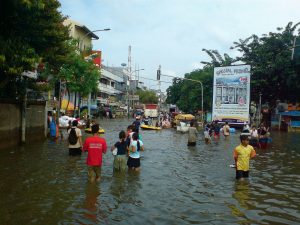The issue of sustainable growth in urban agriculture is especially relevant to Jakarta, as it faces several key issues possibility improved by the increased presence of agriculture in the urban environment.
Food Security: A National Challenge
According to Fiisabiilillah and Maulana (2016, p. 208) food security is considered a “national challenge” under the National Food Act of Indonesia in 2012. This act was implemented to address the issues of food policy, food availability, and food security in Indonesia. Following the 2000 Food and Agricultural Organization definition, food security can be obtained when every person has access to safe and nutritious food to support a healthy and active lifestyle (Fiisabiilillah and Maulana 2016, p. 210).
The objective of food security may be reached through the dimensions of availability, accessibility, utilization, and stability (Fiisabiilillah and Maulana 2016, p. 210). In Jakarta, cases of malnutrition indicate the importance of the utilization dimension. Flooding in Jakarta damages infrastructure, rendering the accessibility of food impossible and highlighting the importance of stability in food security.

Flooding in a marketplace in Maphar, Jakarta.
source: https://www.flickr.com/photos/shanghaidaddy/382761698
In addition to addressing the major issue of food security, increased urban agriculture in Jakarta could work to improve the issues of food imports and poverty. Jakarta is heavily dependent on outside food sources, as 95-99% of food present in Jakarta is imported from elsewhere (Fiisabiilillah and Maulana 2016, p. 213). Urban agriculture could be a solution to this dependence, by fueling local produce. The current general trend in Jakarta is an “increase every year” (Darmawan Listya Cahya 2016, p. 96) in the number of people below the poverty line. This trend suggests that urban agriculture may be needed to provide people with food and possible jobs in the urban cores of Jakarta.
The growth of urban agriculture in the case of Jakarta could have positive economic and social impacts if it is made to be sustainable and functional.
Duri Kosmbi
Darmawan Listya Cahya examines the administrative village of Duri Kosmbi in the metropolitan area of Jakarta to illustrate how urban agriculture functions in this context. Through learning about the benefits and challenges brought to the village by urban agriculture, we can examine how the growth of urban agriculture may be applied and examined in other global contexts. Cahya associates the findings of this case study with the five dimensions of sustainability: ecological, environmental, social, institutional, and technological.
Feasibility of Urban Agriculture
The people involved in urban agricultural practices from the village were typically lower-middle class, and had lower advanced education levels than those not involved. While urban agricultural practices brought benefits to the community through additional food and income, and citizens strongly supported its presence, profits earned by farmers were not meeting their daily needs (Cahya 2016). Many residents were interested in participating in urban agriculture, but were unable to due to the time and costs involved (Cahya 2016).
Sustainability of Urban Agriculture
Cahya measured the sustainability of current urban agricultural practices in Duri Kosmbi through the five dimensions of sustainability and the weight of those dimensions. According to the ecological, economic, and social dimensions, urban agriculture in the village is less sustainable, due to the costs involved in urban agriculture in this context. According to the institutional and technological dimensions, the practice is quite sustainable. (Cahya 2106, p. 98). These results indicate that the practice of urban agriculture needs to be improved in order for it to be truly sustainable in Jakarta and elsewhere. Cahya recommends effective intervention by government and stakeholders to improve the overall sustainability of urban agriculture and its growth for the future.
The case study of urban agriculture in Duri Kosmbi displays the present benefits and challenges of urban agriculture in Jakarta and how it may be improved to aid in the solution of the issues of food security, food imports and poverty faced by Jakarta.
References
Darmawan, L-C. (2016). Analysis of urban agriculture sustainability in Metropolitan Jakarta. Social and Behavioural Sciences 227, pp. 95-100.
Fiisabiilillah, D-F. and Maulana, A. (2016). Feeding the Megacity: Challenges to Achieve Food Security in Jakarta. Journal of Regional and City Planning 27(3), pp. 208-218.